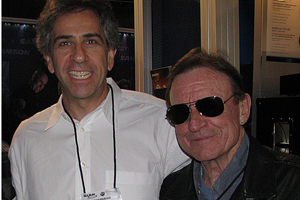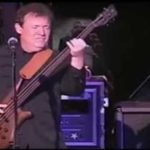From Cream to “Silver Rails,” legendary bassist’s past, present and future
By Gary Graff, Contributing Editor
September 10, 2014
We were deeply saddened to learn of Jack’s death, just weeks after this feature was published. The feature below was published just weeks prior to Jack’s passing. Our follow-up story, including reaction from the music community, can be read here.
“I’ve got this memory,” Jack Bruce says with a laugh. “It’s not so good now for remembering where my specs are, but I do remember the old days very well.”
That’s a good thing because Bruce’s days – of old and new – are the stuff of music, and not just rock ‘n’ roll legend. Spanning more than 50 years – starting with Britain’s Blues Incorporated in 1962 – Bruce has displayed his virtuoso skills as a bassist, singer, songwriter and occasional bandleader to the Graham Bond Organization; John Mayall & the Bluesbreakers; Manfred Mann; BLT; BBM; West, Bruce & Laing; the Golden Palominos and, most famously, Cream. He’s played with Gary Moore and Kip Hanrahan and in Ringo Starr’s All-Starr Band, while his most recent ensemble, Spectrum Road, in an all-star project (Living Colour’s Vernon Reid, John Medeski, Cindy Blackman Santana) that pays homage to the late drumming great Tony Williams.
Bruce is a solo artist, too – has been since 1969’s Songs For a Tailor followed Cream’s split. And this year Bruce took up his own mantle again with Silver Rails, his first new solo album in a decade.
“I hadn’t really thought about making a solo studio album,” says the Scottish-born Bruce, 71, “but I was approached by the guy from the record company, Mark Powell, who’s a guy who’s put out a lot of my back catalog in the past, and he suggested I might want to do that. And of course I jumped at the chance ‘cause I thought it was a good time to make a new album.”
Silver Rails, which came out, is a diverse set whose 10 tracks serve as something of a career summation for Bruce, from the blues of “Reach For the Night” to the pop flavor of “Fields of Forever,” with plenty of nods to his more esoteric and improvisational leanings.
“Some of the songs are pretty laid back for me,” Bruce acknowledges. “But then there’s still things like ‘Hidden Cities,’ which is a pretty intense piece of music and quite amazing. I find it’s very deep. Whenever I’ve done solo albums, I like the diversity of what I’ve come up with, but sometimes it’s a little too diverse, a little too difficult or a little too dark. This one, it’s got dark corners, but I find it quite optimistic in a strange kind of way.”
Bruce recorded Silver Rails at EMI’s famed Abbey Road studios in London, “a fabulous experience” that he says came about by accident. “I was going to do it in another well-known studio in London,” Bruce says, “and I went to see a premiere of my daughter’s new film and met Rob Cass there, who’s the in-house producer of Abbey Road. And he said, ‘Why don’t you come and make the album at Abbey Road?’ “Of course I jumped at the chance of doing that, ‘cause I think it’s the greatest studio in the world. We were working in Studio 2, which is the famous Beatles studio. I’ve worked quite a lot there, going back to the ‘60s, and then there’s the amazing Studio C, which is where The Dark Side of the Moon was recorded and a lot of other good stuff, too. There’s sort of music stuck to the walls, and also the musicians tend to play up a notch because of where you are. It’s all very nice.”
He had plenty of help on the project as well. Guest players include a veritable guitar army – Trower, former Roxy Music guitarist Phil Manzanera, Bernie Marsden, Uli Jon Roth – as well as Medeski, Blackman Santana and even Bruce’s daughter Kyla on backing vocals. He confesses to some mild apprehension, given the gap since More Jack Than God, but those were quickly allayed once he started putting pen to paper with lyricists such as his wife, Margrit Seyffer, longtime mate Pete Brown and Kip Hanrahan.
“I thought it was going to be really hard to come up with songs that worked and that I like, but it turned out to be very, very natural and I just found it was so easy to write,” Bruce says. “I used Songs For a Tailor as a template and I kind of listened to that and I based the kind of atmosphere and the feeling of the songs on Silver Rails on that, so it’s kind of a bookends, if you like.”
Key to that, of course, was the six songs he wrote with Brown, a longtime compatriot with whom he wrote Cream Classics such as “White Room,” “Sunshine of Your Love,” “SWLABR” and “Politician.” “It was excellent working with him, because once we started getting to know each other he could really foretell what was going to happen musically with me, but also in my life itself,” Bruce recalls. “He would come up with lines that would keep coming true. There was one song we wrote called ‘Jet Set Jewel’ that has a line in it, ‘There’s a German girl at the front of the ship cracking a whip,’ or something like that, and not long after that I met my wife, who’s a German girl. “It was scary,” Bruce adds with a laugh. “I had to be careful what I did, otherwise it might end up in a song.”
Bruce says he and Brown write the same way now as they did back in the ‘60s, sometimes with Brown presenting a complete idea and others with the two of them working together in the studio or writing room. The songs on Silver Rails, however, are a little more earthbound than the trippy fare Brown was prone to back in the day. “We’re all a little bit older than we were then, that’s for sure,” Bruce says. “I think his words were great in the ‘60s; they really reflected the sort of abstract feelings that were around at the time. They really echoed what was around in the minds of young people. “I think this must be about the longest songwriting partnership, at least in (England), that’s still working. I don’t know if Jagger and Richards are still writing songs, but we are.”
Working with Brown, of course, can’t help but hearken back to the Cream days and Bruce’s feelings about the trio’s enduring legacy – a heavy footprint for a group that released just four albums over the course of less than three years. “There was a freeing of peoples kind of consciousness back then,” he notes. “I think Ginger (Baker) and myself brought the free jazz influence to rock and Eric (Clapton) certainly brought the blues – not that there hadn’t been other people doing things like that, but I think we were the first band that got a lot of attention for doing it.”
What Cream accomplished, of course, was showing an audience that the two forms had plenty in common. “Let’s just take Ornette Coleman as an example; there’s a lot of blues influences in there, really as there is in all really great jazz,” Bruce explains. “I think that’s at the basis of it. I think in a way I was trying to kind of forget this language that I thought would apply to all kinds of music, folk music from all over the world. They’re all expressing similar ideas and using similar scales to express it.
Cream has reunited periodically over the years – for its 1993 Rock and Roll Hall of Fame induction, for concerts during 2005 in London and New York City and almost at the 2007 tribute to Atlantic Records’ founder Ahmet Ertegun back in London that Led Zeppelin famously headlined. Around that time Bruce declared that “Cream is over,” though he has mixed feelings about whether the group could have been held together back in 1969.
“I often think we could have not been so badly managed and so kind of used up,” he says. “We were never really given a chance to catch our breath and certainly never really given a chance to write together. I think if that had happened we might well have stayed together a little longer – that and if the manager had been a little less greedy and had said, ‘Why don’t you take six months off and just go somewhere and write some stuff and come up with some new ideas.’ Then maybe it wouldn’t have gotten stale. On the other hand, I feel that we had more or less said what we had to say as a band. I think a lot of bands stay together and maybe it’s not such a great thing. Not everybody’s Duke Ellington.”
Post-Silver Rails, Bruce is contemplating his next moves, which includes a hoped-for second album with Spectrum Road. He’s been summering at his vacation home in Majorca, with intentions of making sure it won’t be another decade before his next album comes out. “I’ve already got a couple of songs, so hopefully it will be just as easy and natural as (Silver Rails) was,” Bruce says.



Thanks Gary for a great interview.I am a big fan of jack Bruce and cut my teeth on him when I was first learning how to play bass in 1971.He is a living legend in my opinion.
Thank you.
It’s so uplifting to see and hear Mr.Bruce and marvel at his energy at this point in time . He is an icon for you bassists ,and my appreciation was forged at Cream farewell show in Dallas 1968. As a guitarist expecting to focus on Mr. Clapton and all he brought , I was gobsmacked at Jack’s energetic performance, quickly shuffling my admiration for the 3 of them, equally . Best band ever , pound for pound . Cheers .
What a wonderful interview…..gracious and inspiring by the Real Deal.I am so happy for Jack….enjoying his life and family and sounding great and happy! I am thrilled to know him …..an awesome personality and one of a kind artist. Bless him!!!
I agree with the guys above. Jack’s music is so unique and tirelessly inventive. It is hard to categorise him and we shouldn’t. He has done so much stuff over the years via almost every known musical genre. Just amazing.
This was an excellent interview. If you haven’t seen and heard it, check out Jack with Rory Gallagher, doing “Politician.” It’s an encore and I don’t believe that Rory had played it before. Jack hums the melody to him backstage as they are going on and the interaction between the two, during the solo, especially Bruce’s facial expressions are unforgettable.